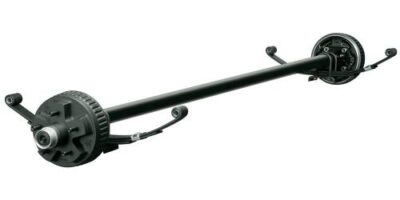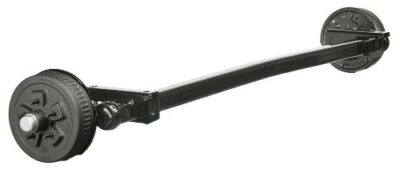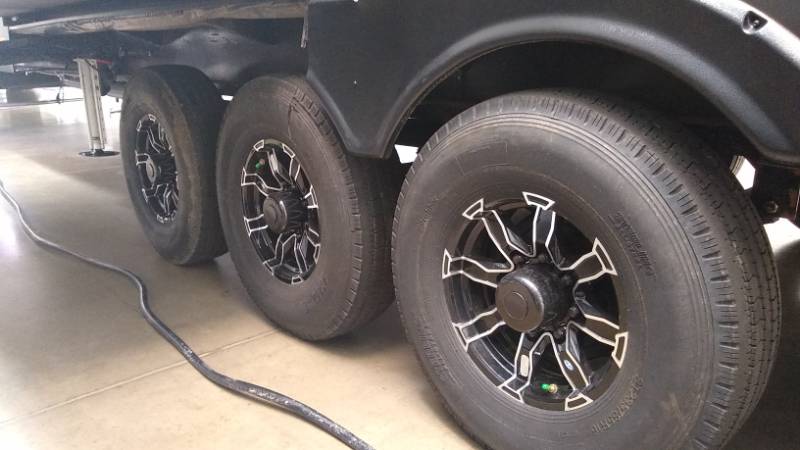If you’re shopping for a travel trailer, you have a decision to make:
Single axle or dual axle?
It’s a hotly debated forum topic. Some die-hard RV owners won’t consider anything else but a tandem axle and try to scare away anyone considering a house on two wheels.
Is that really true? Are you condemning yourself to a sad and lonely future of catastrophic tire blows if you buy a single-axle RV?
I won’t keep you in suspense. Here’s my Spark Notes answer:
If you’re buying a conventional travel trailer and plan on being a “regular RVer,” get a dual-axle trailer. Preferably, choose a tandem leaf-spring suspension or other equalized suspension.
If you’re buying a mini trailer, towing with a small tow vehicle, or plan on exploring the backcountry, you may want to consider a single-axle trailer.
101 Introduction to RV Axle Types
If this is your first peek under the frame of your camper, then here’s what you’re looking for:
- Either a leaf-spring suspension;
- Or a torsion axle suspension.
A few RVs use different types of suspensions, like air bags or independent multi-link. But 99 percent of RVs will have either leaf springs or torsion axles.
You should know how these suspensions work.
By the way: When RVers talk about an “axle,” they’re usually referring to the entire axle and suspension assembly: axle, spindle, tires, springs, hangers, etc. That’s how I’ll use the term in this article, too, even though technically the “axle” is the load-bearing beam that spans the chassis.
Your axle carries the weight of your trailer. It’s the key link in what we engineers call a “load path.” Forces, generated by the weight and motion of your camper, are transferred onto your axle, which transfers them to the ground. Newton’s Third Law and all that.
How an RV Leaf Spring Suspension Works

The leaf-spring suspension has been a hallmark of camper and pickup truck suspensions since time immemorial.
Most RVs still use leaf spring suspensions. It’s a simple, affordable, time-tested design that’s safe, hard to break, and widely available.
However, it’s somewhat … erm … rough and ready. The ride is bumpy. They don’t absorb shock well. And the spring damping varies widely depending on how heavy the load.
Leaf springs are available in slipper or double-eye designs. Slipper springs are used on heavy-duty (6,000+ lbs) axles; double-eye springs are used on light-duty axles (4,000 lbs-). Both designs offer similar performance and ride quality. So honestly, you can pay them no mind.
Pros
- Affordable parts!
- Widely available and easily serviced
- Works well in all weather conditions
- Dual-axle configurations provide weight equalization
Cons
- Rough ride
- Reduced ground clearance
- Adds more weight to camper
- More routine maintenance (painting, lubrication)
How an RV Torsion Axle Suspension Works

Some trailers, especially premium single-axle trailers, may use torsion axles.
These axles use a steel torsion axle surrounded by four rubber cords encased in the main structural beam to provide the suspension. Pretty nifty!
Torsion axles provide a much smoother ride quality than leaf spring axles. However, they aren’t so well suited for heavier, larger campers.
Pros
- Much smoother ride and better handling!
- Semi-independent wheel operation
- Quieter, less squeaky
- Easy installation and replacement
Cons
- May not perform as well in extremely cold weather
- May lose ground clearance over time, especially if camper sits idle for extended periods
- Cannot be easily repaired; usually replaced
- Dual-axle configurations do not provide weight equalization
Why Do Some RVs Have Multiple Axles?

So, why do some trailers have one axle and some have two? Or even three?
Because axles can only carry so much weight.
Think about it. If you expect an axle to carry, say, 5,000 pounds, then each side of the axle must be able to carry at least 2,500. Since the weakest link breaks the chain, every component – tire, rim, lug nut, spindle, bearings – must be rated to do its part. And the bigger the part, the more expensive it becomes.
The typical single axle is rated to carry 3,500-5,000 pounds.
You can purchase axles rated for less. Typically, they will have smaller leaf springs or softer cords to de-rate their weight rating and soften the ride.
You can also purchase axles rated for more. Dexter #10 Torflex axles can go up to 4,000 pounds per axle under certain conditions. Dexter leaf spring axles go from 1,000 all the way to 27,000 lbs!
But you won’t find those heavy-duty axles underneath an RV.
- Most RV torsion axles max out at 4,000 lbs.
- Most RV leaf spring axles max out at 5,000 lbs to 7,000 lbs.
(These limitations exist more because of business and supply chain limitations rather than engineering reasons.
For instance, most trailers use a 5-lug bolt pattern and 10” electric brakes. These components are affordable and widely available.
However, if you want a 6,000-lb axle, you’ll need a 6-lug rim hole pattern and 12” electric brakes. These components are quite a bit more expensive!
So it’s often wiser to pair two or three “typical” axles rather than rely on an expensive single custom axle design that customers and dealers won’t easily find parts for.)
Obviously, many campers weigh a lot more than 4,000 lbs!
So RV engineers place multiple axles underneath a camper to carry the extra weight. Many towable RVs, such as travel trailers and 5th wheels, have two axles. A few extra-heavy RVs, particularly 5th wheels, may have three.
What’s Better for an RV: Single or Dual Axle?
Without further ado, let’s answer the Big Question.
Which is better for RVs: single axle or dual axle?
My answer is … wait for it … (drum roll) … Dual-axle!*
Ha, you thought I was going to say, “It depends,” weren’t you? Well, you caught me. That’s what the asterisk is for. All other things being equal, yes, I do like dual axles better.
*But for smaller travel trailers, there’s nothing wrong with a single axle – and in many cases, it actually works better!
Doing Away With Some Hocus Pocus
Actually, before I begin, let’s get rid of some hocus pocus going around about axle design.
Here’s a quote directly from Airstream’s blog:
“Lighter weight typically translates into less rolling resistance which naturally means you can travel with less road and wind resistance.”
Practically speaking, that is untrue.
Rolling resistance has nothing to do with wind resistance. Wind resistance is based mainly on the size, shape, and surface of the trailer body. The number of axles on your trailer has much less effect.
Another claim I read is that single-axle trailers brake faster.
Again, this is untrue. Braking performance is based on three things:
- Quality and size of your brakes
- Brake controller
- Ratio of camper-weight-to-braking area
A dual-axle trailer with four brakes that weighs 6,000 lbs (1,500 lbs/wheel) should have better braking performance than a single-axle trailer that weighs 3,800 lbs (1,900 lbs/wheel) assuming the brakes are equivalent.
Also, I encourage you to read Roger Marble’s blog about tire safety. In particular, listen to his advice on replacing both tires on an axle if one has failed.
Should I Choose an RV with a Single Axle?
Pros
For all the flack that single-axle trailers get, they’re actually BY FAR the easiest to use.
- Trailer weighs less. You’re only towing the weight of one axle (200+ lbs!) You also might see a small increase in fuel economy.
- Trailer costs less. You’re only paying the cost of one axle ($500+)
- Easier to maneuver. Single-axle trailers can back up and turn on a dime. In a tight spot, single-axle trailers are the clear winner!*
- Cheaper to maintain. You’re only paying for two tires instead of four.
- Easier to tow. The trailer doesn’t have to be perfectly level while towing.
- Better for extreme off-roading. If your camper will be following your Jeep, you need the nimbleness of a single-axle trailer! They have much better approach and departure angles.
*Their maneuverability is a double-edged sword. It also means that single-axle trailers can be “squirrely” to back up, and they easily jackknife.
Cons
Single-axle trailers have two big shortcomings:
- Higher risk of crash in a tire blowout. A catastrophic tire blowout on a single-axle trailer can quickly lead to a catastrophic crash, especially if the trailer is much larger or heavier than the tow vehicle.
- Poor handling at highway speeds. Single-axle trailers, as a rule, don’t track as well at high speeds. They are more prone to trailer sway, porpoising, and other stability issues. That’s why it’s so important that you keep you tongue weight at 10-15 percent of the loaded weight!
- Not so great in soft road conditions. Although single-axle trailers are better for hardcore off-roading, they aren’t as good in sandy or muddy road conditions. It’s easy to get bogged down when all your weight is one or two tires.
These are legitimate safety concerns. And it’s the Number One reason why, in theory, I’m a bigger fan of dual axle suspensions.
HOWEVER … don’t walk away thinking that single-axle trailers aren’t safe!
Many small, lightweight trailers use a single axle – and that’s perfectly fine! There’s no reason to put dual axles underneath, say, a 2,000-lb teardrop trailer or a 3,500-lb fiberglass mini camper. Not only is that a needless expense, but considering that every pound counts, it would be extremely wasteful to add the extra 200 lbs. And these campers are often towed into the boondocks, where they need excellent maneuverability.
Single axles are the perfect choice for small, lightweight travel trailers. If you find one, don’t hesitate to buy it!
But …
I don’t like when RV designers put single axles underneath long, lightweight conventional travel trailers.
When a camper gets to be 18-20 feet or longer, or weighs more than 4,000 lbs dry weight, it’s time to start looking at dual axles.
Long conventional trailers on single axles are infamous for trailer sway. And it makes sense! All those crosswinds pushing on the sidewalls, forcing the camper to rotate around its single axle (which will very happily turn on a dime, remember?). Yikes.
Long conventional trailers weighing more than 4,000 lbs dry weight on a single axle typically have very poor cargo carrying capacity. They’re too maxed out. By the time you fill up the cabinets and add the bikes, you may already be overloaded!
Actually, poor cargo-carrying capacity is a big deal for many RVs! Read my expose here.
Should I Choose an RV with a Dual Axle?
So, first of all, I should define what I mean by “dual axle.” There are two types of double axle setups: twin and tandem.
- Twin dual axles operate independently of each other. Twin torsion axles, for instance, act as individual weight-carrying axles. They don’t share the load in between them.
- Tandem axles equalize the load. So if you hit a bump or a pothole, the front axle will share part of the load with the rear axle, rather than absorbing the entire load itself. (In other words, at that moment, it becomes a single-axle trailer!) This reduces the chance of the overloading.
As a rule, dual leaf spring suspensions are tandem axles; dual torsion axles are twin axles.
Twin axles are not recommended. I won’t go out and condemn them. In theory, they can be done properly. But because twin axles don’t equal the load front-to-back, they are at severe risk of being overloaded, either if the road is uneven (e.g., pothole) or the trailer is uneven while being towed.
Here’s an excellent article at MechanicalElements.com that dives further into this issue.
IMHO, the safest way to use twin axles (such as double torsion axles) is to build in a large factor of safety into the system so … but then, why not just go with tandem leaf springs and add rubber bushings or shocks for shock damping?
Pros
A dual axle design has three key benefits over a big, beefy single:
- Tire safety. If you blow out a tire, you’ll usually have time to pull over before affecting any other tires. After all, you have three more tires!
- Tire and rim size. As I mentioned before, you can use commonly available and affordable parts with dual axles compared to a single beefy custom axle.
- Load distribution. Multiple axles spread out the weight of the camper over the frame chassis rails. This is far stronger than concentrating the weight at one or two points.
- Less sway. A dual-axle trailer usually tracks better and sways less than a comparable single-axle trailer. If you plan to do a lot of cross-country traveling, a dual axle is highly recommended!
- More weight capacity. The more axles, the more weight you can carry. That means a bigger cargo carrying capacity, so you can bring more toys!
- Tongue weight may weigh less. All trailers should have 10-15 percent on the tongue, but you may find double-axle trailers toward the lower end of that range.
Cons
- Trailer costs more. Suspension assemblies aren’t cheap. You’ll pay at least $1,000 more compared to an equivalent single-axle trailer.
- Trailer weighs more. Axles are heavy! They’re mostly steel. If you’re towing with a passenger vehicle like a CUV, consider sticking to a single-axle RV.
- Higher cost of maintenance. Now you’re paying for four tires, four wheel bearing services, etc.
- Can’t turn as well. Dual-axle trailers do not turn as easily as a single-axle trailer. The tires “scrub.” In fact, trying to turn a dual-axle trailer on a dime can severely and permanently damage the tires due to lateral shear forces. Again, see Roger Marble’s Tire Safety blog for more details.
The takeaway: If you’re shopping for a teardrop, mega teardrop, or mini travel trailer, a single axle is probably just fine. If you’re shopping for a conventional trailer or 5th wheel, stick to a dual or triple axle!
Summary Advice
To recap: If you’re buying a conventional travel trailer and plan on being a “regular RVer,” get a dual-axle or triple-axle trailer. Preferably, choose a tandem leaf-spring suspension or other equalized suspension with shock-absorbing technology.
If you’re buying a mini trailer, towing with a small tow vehicle, or plan on exploring the backcountry, you may want to consider a single-axle trailer, especially a torsion axle.
Leave a Reply